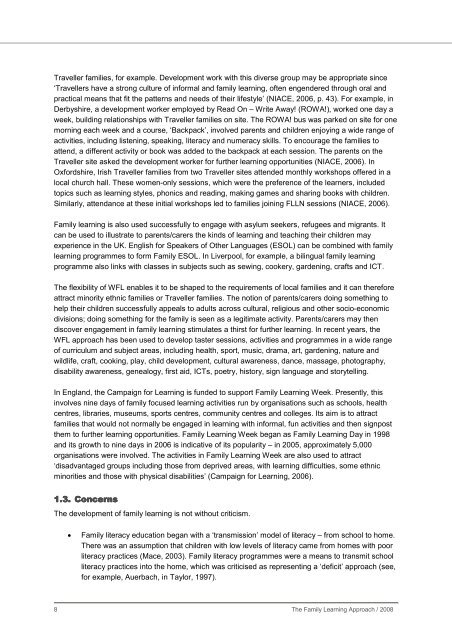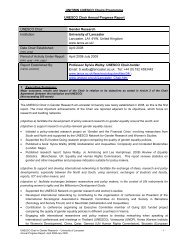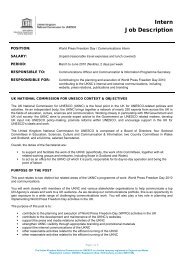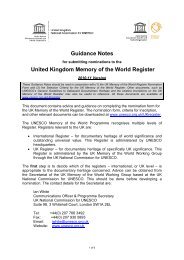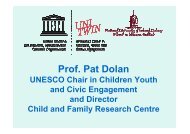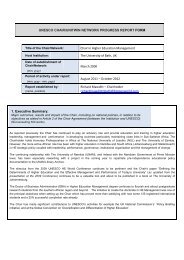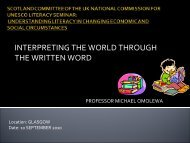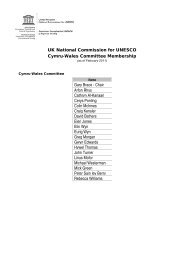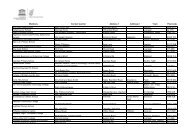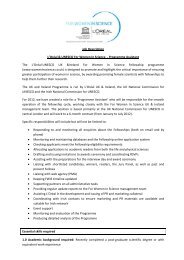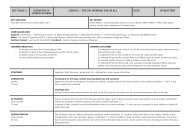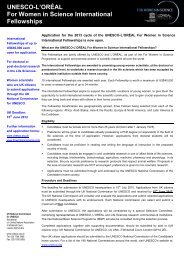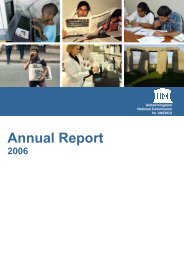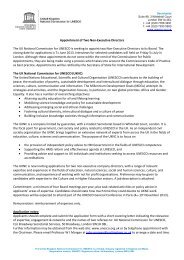The Family Learning Approach - UK National Commission for ...
The Family Learning Approach - UK National Commission for ...
The Family Learning Approach - UK National Commission for ...
Create successful ePaper yourself
Turn your PDF publications into a flip-book with our unique Google optimized e-Paper software.
Traveller families, <strong>for</strong> example. Development work with this diverse group may be appropriate since‘Travellers have a strong culture of in<strong>for</strong>mal and family learning, often engendered through oral andpractical means that fit the patterns and needs of their lifestyle’ (NIACE, 2006, p. 43). For example, inDerbyshire, a development worker employed by Read On – Write Away! (ROWA!), worked one day aweek, building relationships with Traveller families on site. <strong>The</strong> ROWA! bus was parked on site <strong>for</strong> onemorning each week and a course, ‘Backpack’, involved parents and children enjoying a wide range ofactivities, including listening, speaking, literacy and numeracy skills. To encourage the families toattend, a different activity or book was added to the backpack at each session. <strong>The</strong> parents on theTraveller site asked the development worker <strong>for</strong> further learning opportunities (NIACE, 2006). InOx<strong>for</strong>dshire, Irish Traveller families from two Traveller sites attended monthly workshops offered in alocal church hall. <strong>The</strong>se women-only sessions, which were the preference of the learners, includedtopics such as learning styles, phonics and reading, making games and sharing books with children.Similarly, attendance at these initial workshops led to families joining FLLN sessions (NIACE, 2006).<strong>Family</strong> learning is also used successfully to engage with asylum seekers, refugees and migrants. Itcan be used to illustrate to parents/carers the kinds of learning and teaching their children mayexperience in the <strong>UK</strong>. English <strong>for</strong> Speakers of Other Languages (ESOL) can be combined with familylearning programmes to <strong>for</strong>m <strong>Family</strong> ESOL. In Liverpool, <strong>for</strong> example, a bilingual family learningprogramme also links with classes in subjects such as sewing, cookery, gardening, crafts and ICT.<strong>The</strong> flexibility of WFL enables it to be shaped to the requirements of local families and it can there<strong>for</strong>eattract minority ethnic families or Traveller families. <strong>The</strong> notion of parents/carers doing something tohelp their children successfully appeals to adults across cultural, religious and other socio-economicdivisions; doing something <strong>for</strong> the family is seen as a legitimate activity. Parents/carers may thendiscover engagement in family learning stimulates a thirst <strong>for</strong> further learning. In recent years, theWFL approach has been used to develop taster sessions, activities and programmes in a wide rangeof curriculum and subject areas, including health, sport, music, drama, art, gardening, nature andwildlife, craft, cooking, play, child development, cultural awareness, dance, massage, photography,disability awareness, genealogy, first aid, ICTs, poetry, history, sign language and storytelling.In England, the Campaign <strong>for</strong> <strong>Learning</strong> is funded to support <strong>Family</strong> <strong>Learning</strong> Week. Presently, thisinvolves nine days of family focused learning activities run by organisations such as schools, healthcentres, libraries, museums, sports centres, community centres and colleges. Its aim is to attractfamilies that would not normally be engaged in learning with in<strong>for</strong>mal, fun activities and then signpostthem to further learning opportunities. <strong>Family</strong> <strong>Learning</strong> Week began as <strong>Family</strong> <strong>Learning</strong> Day in 1998and its growth to nine days in 2006 is indicative of its popularity – in 2005, approximately 5,000organisations were involved. <strong>The</strong> activities in <strong>Family</strong> <strong>Learning</strong> Week are also used to attract‘disadvantaged groups including those from deprived areas, with learning difficulties, some ethnicminorities and those with physical disabilities’ (Campaign <strong>for</strong> <strong>Learning</strong>, 2006).1.3. Concerns<strong>The</strong> development of family learning is not without criticism.• <strong>Family</strong> literacy education began with a ‘transmission’ model of literacy – from school to home.<strong>The</strong>re was an assumption that children with low levels of literacy came from homes with poorliteracy practices (Mace, 2003). <strong>Family</strong> literacy programmes were a means to transmit schoolliteracy practices into the home, which was criticised as representing a ‘deficit’ approach (see,<strong>for</strong> example, Auerbach, in Taylor, 1997).8 <strong>The</strong> <strong>Family</strong> <strong>Learning</strong> <strong>Approach</strong> / 2008


